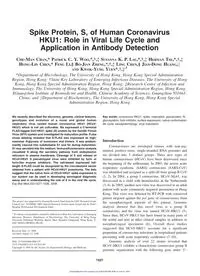
2008 Spike Protein, S, of Human Coronavirus HKU1_ Role in Viral Life Cycle and Application in Antibody Detection PDF
Preview 2008 Spike Protein, S, of Human Coronavirus HKU1_ Role in Viral Life Cycle and Application in Antibody Detection
Spike Protein, S, of Human Coronavirus HKU1: Role in Viral Life Cycle and Application in Antibody Detection CHE-MAN CHAN,* PATRICK C. Y. WOO,*,�,� SUSANNA K. P. LAU,*,�,� HERMAN TSE,*,�,� HONG-LIN CHEN,* FENG LI,§ BO-JIAN ZHENG,*,�,� LING CHEN,§ JIAN-DONG HUANG,jj AND KWOK-YUNG YUEN*,�,�,1 *Department of Microbiology, The University of Hong Kong, Hong Kong Special Administration Region, Hong Kong; �State Key Laboratory of Emerging Infectious Diseases, The University of Hong Kong, Hong Kong Special Administration Region, Hong Kong; �Research Centre of Infection and Immunology, The University of Hong Kong, Hong Kong Special Administration Region, Hong Kong; §Guangzhou Institute of Biomedicine and Health, Chinese Academy of Sciences, Guangzhou 501663, China; and jjDepartment of Biochemistry, The University of Hong Kong, Hong Kong Special Administration Region, Hong Kong We recently described the discovery, genome, clinical features, genotypes and evolution of a novel and global human respiratory virus named human coronavirus HKU1 (HCoV- HKU1) which is not yet culturable. We expressed a C-terminal FLAG-tagged CoV-HKU1 spike (S) protein by the Semliki Forest Virus (SFV) system and investigated its maturation profile. Pulse chase labeling revealed that S-FLAG was expressed as high- mannose N-glycans of monomers and trimers. It was predom- inantly cleaved into subdomains S1 and S2 during maturation. S1 was secreted into the medium. Immunofluorescence analysis visualized S along the secretory pathway from endoplasmic reticulum to plasma membrane. Cleavage of S and release of HCoV-HKU1 S pseudotyped virus were inhibited by furin or furin-like enzyme inhibitors. The cell-based expressed full- length S-FLAG could be recognized by the convalescent serum obtained from a patient with HCoV-HKU1 pneumonia. The data suggest that the native form of HCoV-HKU1 spike expressed in our system can be used in developing serological diagnostic assay and in understanding the role of S in the viral life cycle. Exp Biol Med 233:1527–1536, 2008 Key words: coronavirus HKU1; spike; maturation; glycoprotein; N- glycosylation; furin inhibitor; surface expression; native conformation; life cycle; seroepidemiology; virus maturation Introduction Coronaviruses are enveloped viruses with non-seg- mented, positive-sense, single-stranded RNA genomes and are divided into 3 distinct groups. Three new types of human coronaviruses (HCoV) have been discovered since the beginning of the millennium. In 2003, the severe acute respiratory syndrome (SARS) coronavirus (SARS-CoV) was identified and assigned as a split-off from group II CoV (1, 2). In 2004, a group I coronavirus, HCoV-NL63, was discovered in a child with bronchiolitis in the Netherlands (3, 4). In 2005, another new virus was discovered in an adult patient with acute community acquired pneumonia in Hong Kong. This virus was detected by RT-PCR with conserved primer targeted against the pol gene of coronaviruses from the nasopharyngeal aspirate of this patient. Genomic analysis showed that this novel virus is a group II coronavirus, and the virus was named HCoV-HKU1 (5). Since then, HCoV-HKU1 has been found in many parts of the world and also in other clinical samples in addition to nasopharyngeal specimens (6). Overall these studies suggested that HCoV-HKU1 accounts for a significant proportion of coronavirus infections in hospitalized patients presenting with acute respiratory syndromes (7–10). Genomic analysis of over 22 strains revealed that HCoV-HKU1 exhibits a characteristic coronavirus group II genomic organization with the following gene order: 59- This project was supported by General Research Fund from the UGC Research Grants Council (ref: 781008M), HKU Special Research Achievement Award and St. Paul’s Hospital Professional Development Fund. 1 To whom correspondence should be addressed at State Key Laboratory of Emerging Infectious Diseases, Department of Microbiology, The University of Hong Kong, University Pathology Building, Queen Mary Hospital Compound, Hong Kong. E- mail:
